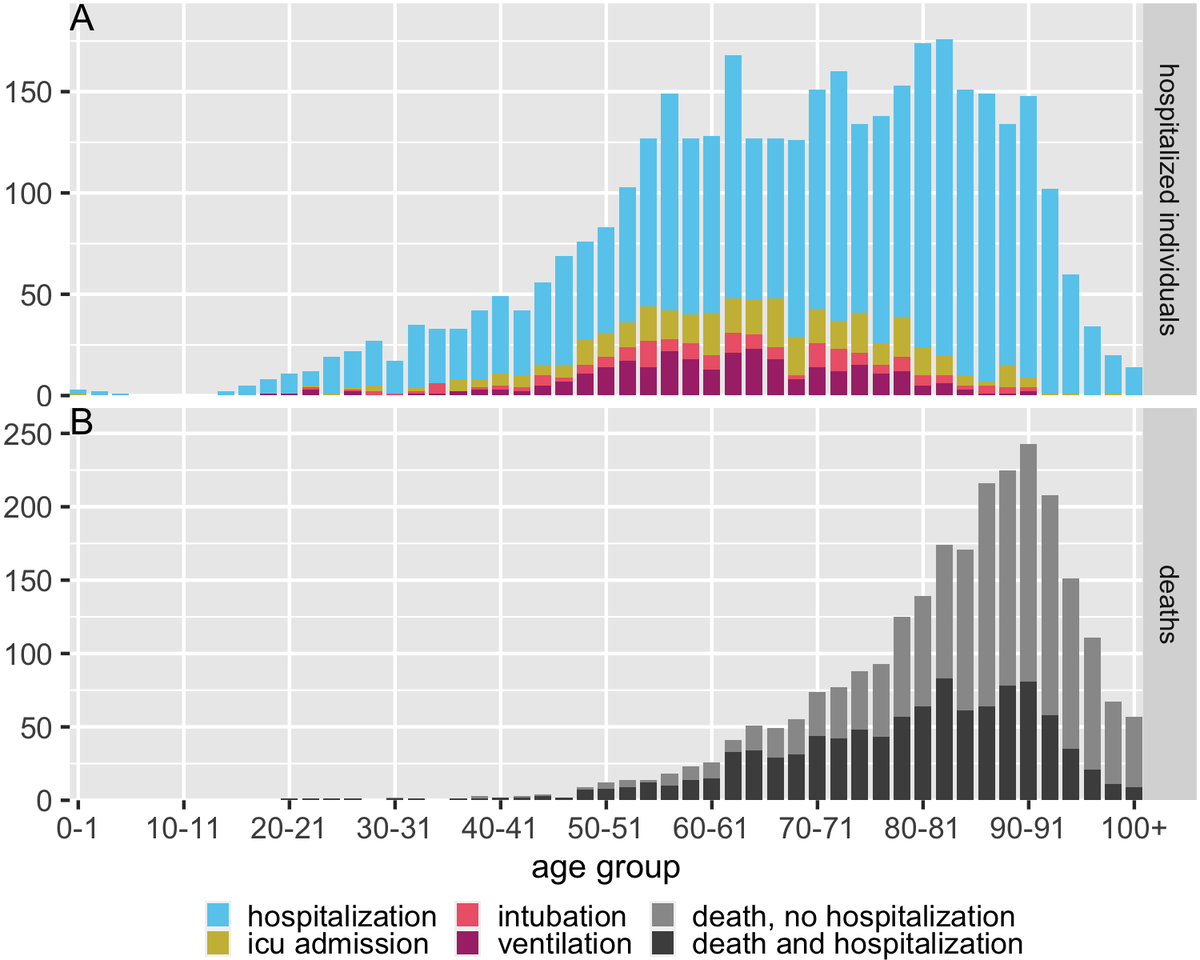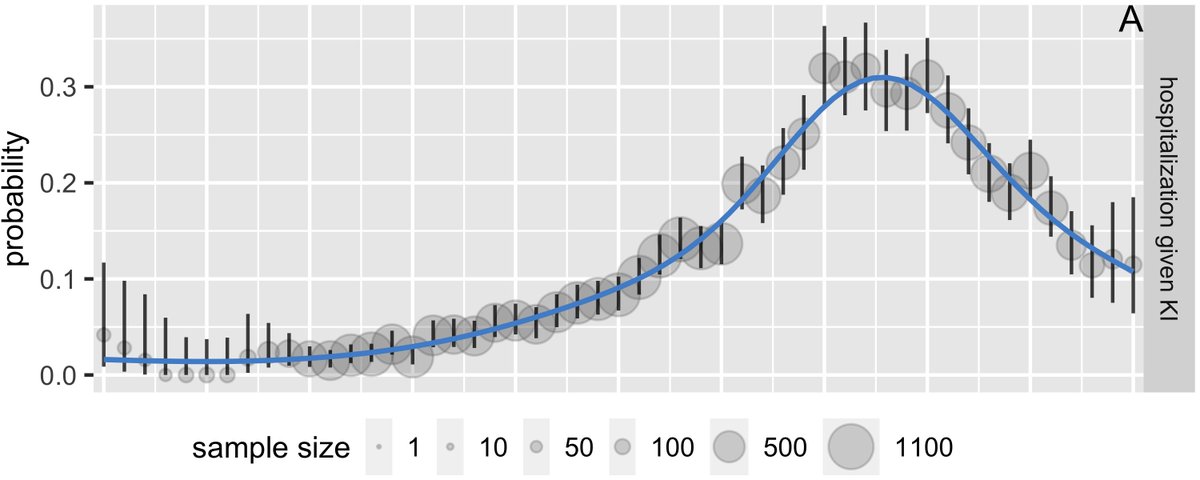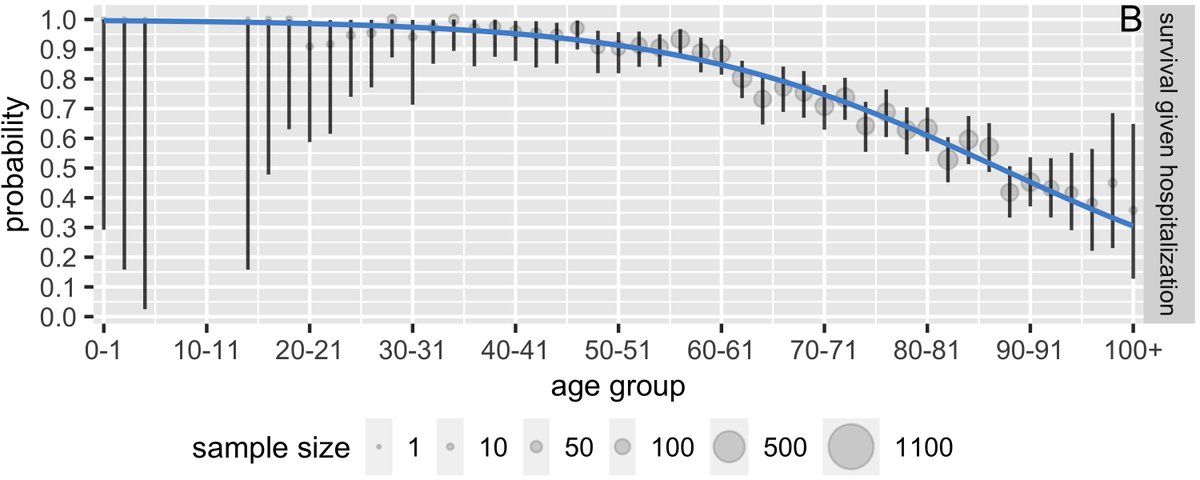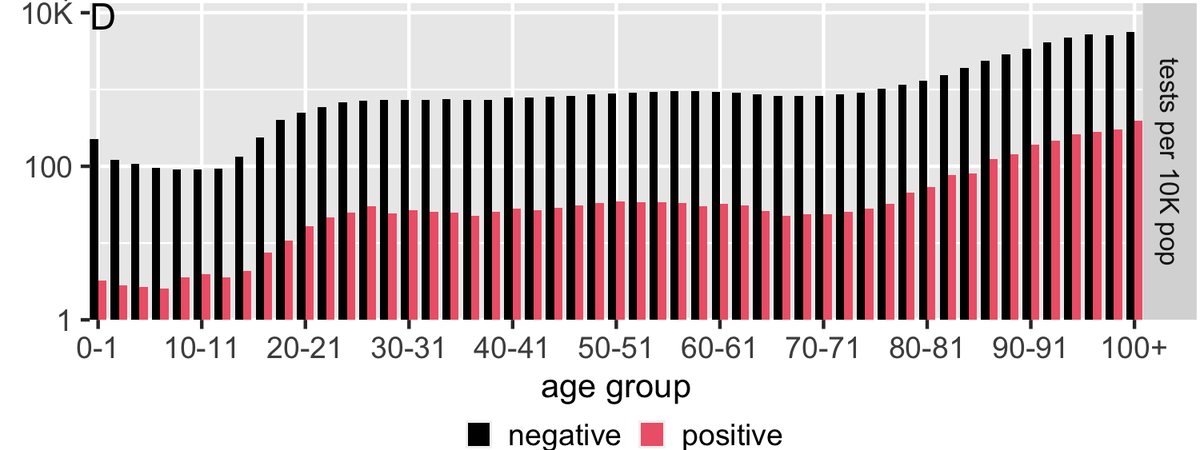we know #COVID19 severity depends on age, but we mostly see the ages of those dying… what about serious, but non-fatal, outcomes like hospitalization? ICU admission? intubation? ventilator use? how old are people receiving these healthcare interventions for #COVID19?
we ( @MLiwz1, @DChampredon, @bolkerb, @jd_mathbio, @DavidJDEarn, and i) looked at the ages of ontarians infected with #coronavirus during the first five months of our epidemic, and what happened to them.
here& #39;s what we found:
here& #39;s what we found:
1) while #COVID19 deaths are sharply concentrated in the very elderly (~90-year-olds), hospitalizations are spread over a broad age range (~54-90). the majority of deaths (~60%) have occurred in individuals with no record of hospitalization.
2) the probability of hospitalization given a known #coronavirus infection generally increases with age, peaking around age 75 at about 32%, and then decreases after this age. (the vertical bars are 95% confidence intervals.)
3) the probability of survival given hospitalization is near 100% for adults under 40, but dips after that age. (estimates are unreliable for children because of small sample sizes.) a 50-year-old hospitalized for #COVID19 has a 1 in 10 chance of dying.
here& #39;s what we think these results mean:
1) there has been a need for #COVID19 hospitalization beyond seniors, even when the outbreak has been kept in check and healthcare resources have not been overextended. this virus is not just a serious concern for the elderly.
1) there has been a need for #COVID19 hospitalization beyond seniors, even when the outbreak has been kept in check and healthcare resources have not been overextended. this virus is not just a serious concern for the elderly.
2) if spread of the virus were to increase in the province, and hospitals were unable to keep up with the demand for #COVID19 treatment, it& #39;s possible that we would see more deaths in younger ages than we& #39;ve seen so far.
3) we& #39;ve worked extremely hard to keep #coronavirus spread low and slow---not just the gov/public health, but every. single. one of us: masking up, washing hands, physical distancing. we need to keep up the good work.
fall is coming. we don& #39;t yet know whether #coronavirus will spread more easily when the weather changes, but we do know that gathering indoors is particularly risky and socializing outdoors will become harder.
some important notes on our analysis:
1) we have not been testing children for #coronavirus as frequently as other age groups, likely due to testing guidelines which filtered for symptoms that are generally less severe & less common in kids. (the y-axis here is on a log scale!)
1) we have not been testing children for #coronavirus as frequently as other age groups, likely due to testing guidelines which filtered for symptoms that are generally less severe & less common in kids. (the y-axis here is on a log scale!)
this does not necessarily mean that children are being infected less often, but rather that we are possibly *detecting* infection in children less often, and so we have a less reliable picture of what is happening with those under 20. same goes for asymptomatic infections.
2) *any* study relying on data from #coronavirus tests that first screen for "common" symptoms (i.e. testing for cause) are subject to these same detection biases. we need broad surveillance testing.
3) our estimates are specific to the way #COVID19 has spread in ontario, but they have important implications for similar regions experiencing #COVID19 around the world.
the full preprint is available on medRxiv & has not yet been peer reviewed, so take these results with a grain of salt! like everything, it& #39;s a work-in-progress, so all constructive questions, comments, and concerns are welcome  https://abs.twimg.com/emoji/v2/... draggable="false" alt="🙏" title="Folded hands" aria-label="Emoji: Folded hands"> https://www.medrxiv.org/content/10.1101/2020.09.01.20186395v1">https://www.medrxiv.org/content/1...
https://abs.twimg.com/emoji/v2/... draggable="false" alt="🙏" title="Folded hands" aria-label="Emoji: Folded hands"> https://www.medrxiv.org/content/10.1101/2020.09.01.20186395v1">https://www.medrxiv.org/content/1...
data and source code will be made available in the future, i promise!  https://abs.twimg.com/emoji/v2/... draggable="false" alt="👩💻" title="Woman technologist" aria-label="Emoji: Woman technologist">
https://abs.twimg.com/emoji/v2/... draggable="false" alt="👩💻" title="Woman technologist" aria-label="Emoji: Woman technologist">

 Read on Twitter
Read on Twitter





